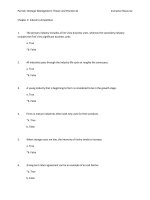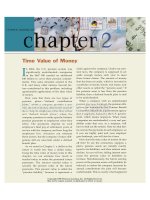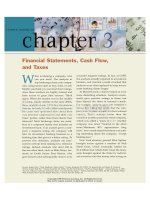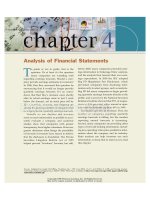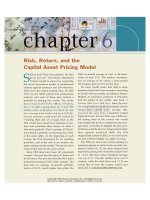Portfolio management theory and practice
Bạn đang xem bản rút gọn của tài liệu. Xem và tải ngay bản đầy đủ của tài liệu tại đây (18.95 MB, 854 trang )
Table of Contents
Cover
About the Authors
Acknowledgments
Preface
SUPPLEMENTS
ENDNOTE
CHAPTER 1: Introduction
1.1 INTRODUCTION TO THE INVESTMENT INDUSTRY
1.2 WHAT IS A PORTFOLIO MANAGER?
1.3 WHAT INVESTMENT PROBLEMS DO PORTFOLIO MANAGERS SEEK TO
SOLVE?
1.4 SPECTRUM OF PORTFOLIO MANAGERS
1.5 LAYOUT OF THIS BOOK
PROBLEMS
ENDNOTES
CHAPTER 2: Client Objectives for Diversified Portfolios
2.1 INTRODUCTION
2.2 DEFINITIONS OF RISK
2.3 THE PORTFOLIO MANAGEMENT PROCESS AND THE INVESTMENT
POLICY STATEMENT
2.4 INSTITUTIONAL INVESTORS
2.5 INDIVIDUAL INVESTORS
2.6 ASSET CLASS PORTFOLIOS
SUMMARY
PROBLEMS
ENDNOTES
CHAPTER 3: Asset Allocation: The Mean - Variance Framework
3.1 INTRODUCTION: MOTIVATION OF THE MEAN–VARIANCE APPROACH
TO ASSET ALLOCATION
3.2 THEORY: OUTLINE OF THE MEAN–VARIANCE FRAMEWORK
3.3 PRACTICE: SOLUTION OF STYLIZED PROBLEMS USING THE MEAN–
VARIANCE FRAMEWORK
SUMMARY
PROBLEMS
APPENDIX 1: RETURNS, COMPOUNDING, AND SAMPLE STATISTICS
APPENDIX 2: OPTIMIZATION
APPENDIX 3: NOTATION
ENDNOTES
CHAPTER 4: Asset Allocation Inputs
4.1 SENSITIVITY OF THE MEAN–VARIANCE MODEL TO INPUTS
4.2 CONSTANT INVESTMENT OPPORTUNITIES
4.3 TIME-VARYING INVESTMENT OPPORTUNITIES
SUMMARY
PROBLEMS
APPENDIX: MIXED ESTIMATION WITH MULTIPLE ASSETS
ENDNOTES
CHAPTER 5: Advanced Topics in Asset Allocation
5.1 INTRODUCTION
5.2 HORIZON EFFECTS IN THE M-V FRAMEWORK
5.3 DYNAMIC PROGRAMMING
5.4 SIMULATION
5.5 ASSET ALLOCATION WITH ACTIVE MANAGERS
5.6 PORTFOLIO INSURANCE
SUMMARY
PROBLEMS
APPENDIX 1: THE ESTIMATED VAR1 MODEL
APPENDIX 2: DP SOLUTION OF THE MEAN REVERSION MODEL
ENDNOTES
CHAPTER 6: The Investment Management Process
6.1 INTRODUCTION
6.2 THE EFFICIENT MARKET HYPOTHESIS (EMH)
6.3 GENERAL DISCUSSION OF INVESTMENT STRATEGIES
6.4 THE FIVE KEY ELEMENTS OF THE INVESTMENT PROCESS
6.5 THE IMPORTANCE OF QUALITY CONTROL AND OTHER
RECOMMENDATIONS
6.6 A SAMPLE INVESTMENT STRATEGY: THE SRY MODEL
SUMMARY
PROBLEMS
ENDNOTES
CHAPTER 7: Introduction to Equity Portfolio Investing: The Investor's View
7.1 INTRODUCTION
7.2 EQUITY STRATEGIES
7.3 SELECTING THE EQUITY MIX
7.4 ALTERNATIVE EQUITY MIXES
7.5 THE EQUITY MANAGEMENT BUSINESS
7.6 IMPLEMENTING THE EQUITY MIX
7.7 EQUITY PORTFOLIO INVESTMENT OBJECTIVES
SUMMARY
PROBLEMS
ENDNOTES
CHAPTER 8: Equity Portfolio Construction
8.1 INTRODUCTION
8.2 PASSIVE VERSUS ACTIVE MANAGEMENT
8.3 PASSIVE PORTFOLIO CONSTRUCTION
8.4 GOALS FOR ACTIVE MANAGEMENT
8.5 SECTOR MANAGEMENT
8.6 STYLE AND SECTOR MANAGEMENT
8.7 IDENTIFYING STYLE
8.8 SAMPLE ACTIVE PORTFOLIO
SUMMARY
PROBLEMS
ENDNOTES
CHAPTER 9: Fixed-Income Management
9.1 INTRODUCTION
9.2 FIXED-INCOME MARKETS, INSTRUMENTS, AND CONCEPTS
9.3 FIXED-INCOME MANDATES
9.4 PASSIVE MANAGEMENT
9.5 ACTIVE MANAGEMENT
9.6 STRUCTURED PORTFOLIOS
SUMMARY
PROBLEMS
ENDNOTES
CHAPTER 10: Global Investing
10.1 INTRODUCTION
10.2 INVESTING WITH A GLOBAL PERSPECTIVE
10.3 GLOBAL INVESTMENT OPPORTUNITIES
10.4 THE IMPACT OF CURRENCY
10.5 INTERNATIONAL DIVERSIFICATION: FAILURE TO DELIVER?
10.6 IMPLICATIONS OF GLOBALIZATION
10.7 CURRENCY OVERLAYS: INCENTIVE-COMPATIBLE PERFORMANCE
EVALUATION
SUMMARY
PROBLEMS
ENDNOTES
CHAPTER 11: Alternative Investment Classes
11.1 INTRODUCTION
11.2 HEDGE FUNDS
11.3 VENTURE CAPITAL AND PRIVATE EQUITY
11.4 REAL ESTATE
11.5 COMMODITIES
11.6 ALTERNATIVES MANAGER SELECTION
11.7 ALLOCATING ASSETS INCLUDING ALTERNATIVES
SUMMARY
PROBLEMS
APPENDIX: SOURCES FOR RETURN SERIES
ENDNOTES
CHAPTER 12: Portfolio Management Through Time: Taxes and Transaction Costs
12.1 INTRODUCTION
12.2 PERFORMANCE SHORTFALL
12.3 PORTFOLIO ADJUSTMENTS WITHOUT TAXES OR COSTS
12.4 TRANSACTION COSTS
12.5 TAXATION OF INVESTMENT RETURNS IN THE UNITED STATES
12.6 STRATEGIES TO REDUCE INDIVIDUAL INVESTOR TAXES
12.7 TAX MANAGING A PORTFOLIO OF SECURITIES
SUMMARY
PROBLEMS
ENDNOTES
CHAPTER 13: Performance Measurement and Attribution
13.1 INTRODUCTION
13.2 PERFORMANCE MEASUREMENT
13.3 PERFORMANCE ATTRIBUTION
13.4 PERFORMANCE APPRAISAL: INCENTIVE EFFECTS
SUMMARY
PROBLEMS
APPENDIX: CALCULATION OF RISK MEASURES
ENDNOTES
CHAPTER 14: Incentives, Ethics, and Policy
14.1 INTRODUCTION
14.2 THE INVESTMENT COMPANY BUSINESS MODEL
14.3 INCENTIVES FOR BUSINESSPEOPLE AND PORTFOLIO MANAGERS
14.4 ETHICAL SITUATIONS
14.5 INDUSTRY GUIDELINES FOR GOOD BUSINESS PRACTICES
14.6 INTERNAL COMPANY POLICIES TO PROTECT THE FRANCHISE
14.7 EFFECTIVE MANAGER AND ANALYST COMPENSATION POLICIES
SUMMARY
PROBLEMS
APPENDIX: SAMPLE LIST OF INVESTMENT POLICIES
ENDNOTES
CHAPTER 15: Investor and Client Behavior
15.1 INTRODUCTION
15.2 THEORY AND OBSERVATIONS OF HUMAN BEHAVIOR
15.3 IMPLICATIONS FOR ACTIVE MANAGEMENT
15.4 IMPLICATIONS FOR SETTING INVESTMENT POLICY
15.5 IMPLICATIONS FOR MANAGER SELECTION
SUMMARY
PROBLEMS
ENDNOTES
CHAPTER 16: Managing Client Relations
16.1 INTRODUCTION
16.2 GENERAL RECOMMENDATIONS FOR CLIENT MANAGEMENT
16.3 MEETING CLIENT NEEDS
16.4 MANAGER SELECTION PROCESS
16.5 SECURING NEW CLIENTS
16.6 RETAINING CLIENTS
16.7 CASE STUDY
SUMMARY
PROBLEMS
ENDNOTES
Sample Cases
Jerry W.
PRIVATE WEALTH CASE: DESIGNING AN INVESTMENT PLAN FOR JERRY
W.
APPENDICES
INVESTOR QUESTIONNAIRE
ENDNOTES
MSSI
DEFINED BENEFIT PLAN CASE: DESIGNING THE INVESTMENT
STRUCTURE FOR MSSI CORPORATION'S DEFINED BENEFIT PLAN
McClain Capital
DEFINED CONTRIBUTION PLAN CASE: DESIGNING A CUSTOM DEFINED
CONTRIBUTION PLAN
The Fairbanks Fund
FUND CASE: THE FAIRBANKS SMALL-CAP U.S. EQUITY FUND
WHITTIER WEALTH MANAGEMENT: FAIRBANKS SMALL-CAP EQUITY
FUND
Glossary
References
Index
End User License Agreement
List of Tables
Chapter 2
EXHIBIT 2.3 Ten Largest U.S. Fou ndations
EXHIBIT 2.4 Ten Largest U.S. Endowments
Chapter 3
EXHIBIT 3.1 Historical Correlations: Monthly Gross Returns, 45 Years Ending...
EXHIBIT 3.2 Historical Returns: Annualized Gross, Ending 12/31/2016
EXHIBIT 3.3 Historical Standard Deviation: Annual Gross Returns, Ending...
Chapter 4
EXHIBIT 4.1 95% Confidence Intervals for Expected Return
EXHIBIT 4.2 95% Confidence Intervals for the Sample Standard Deviation
EXHIBIT 4.3 James–Stein Estimation: Monthly Data 1985–2016
EXHIBIT 4.4 Decomposition of S&P 500 Returns: Log Returns 1946–2016
EXHIBIT 4.5 Implied Views
EXHIBIT 4.7 Factor Model Exposures and Risk Premiums
EXHIBIT 4.9 Election Cycle for S&P 500: Log Returns 1929–2016
EXHIBIT 4.10 Models of S&P 500: Annual Log Returns 1946–2016
Chapter 5
EXHIBIT 5.8 Current Return versus Future Opportunities
EXHIBIT 5.12 Impact of Cash Flows and Alternative Probability Distributions
EXHIBIT 5.14 Mean-Lower Partial Moment Optimization
EXHIBIT 5.15 Distribution of Portfolios from Statistically Equivalent Inputs
Chapter 6
EXHIBIT 6.1 The Investment Process: Signal-Based Decision Making
EXHIBIT 6.2 Issues to Explore When Designing a Paper Portfolio
EXHIBIT 6.3 Implementation: Liquidity, Value Added, and Capacity
EXHIBIT 6.4 Feedback: Performance at Each Step
EXHIBIT 6.6 Cycle of Asset Price Levels
EXHIBIT 6.8 Tactical Asset Allocation Signal
EXHIBIT 6.10 Sample Market Characteristics: Stock (SPY) and Bond (AGG)
ETFs
EXHIBIT 6.11 Representative Bid–Ask Spread and Market Impact Data: Stoc...
EXHIBIT 6.12 Representative Transaction Cost Data: SPY ETF Sample OneWay...
EXHIBIT 6.13 Simulation Results: Tactical Asset Allocation Strategy...
Chapter 7
EXHIBIT 7.1 Russell Equity Style Indexes
EXHIBIT 7.2 Historical Correlations: Gross Monthly Russell and EAFE Equity...
EXHIBIT 7.3 Annualized Historical Gross Returns: Russell and EAFE Equity
Inde...
EXHIBIT 7.4 Historical Standard Deviation, Gross Annual Returns: Russell
and...
EXHIBIT 7.5 Market Valuations: Percentages of Equity Market—U.S. Equity...
EXHIBIT 7.8 Mean–Variance Alternative Portfolios: Equity Asset Classes
EXHIBIT 7.9 Equity Asset Class Log Return Expectations (α): Historical...
EXHIBIT 7.10 Optimal Equity Mix (Maximized Risk–Return Trade-Off) Using...
EXHIBIT 7.11 Stress Test Results: Alternative Equity Mixes (Described in Exhi...
EXHIBIT 7.13 Comparing Portfolio Characteristics
EXHIBIT 7.14 Sample Equity Mix: Mutual Fund
EXHIBIT 7.15 Sample Equity Mix: Institutional Fund
Chapter 8
EXHIBIT 8.5 Lipper's U.S. Equity Mutual Fund Classifications
EXHIBIT 8.6 Sample Weighting Algorithm for a 25 Percent Weighted Sector
EXHIBIT 8.8 Sample Portfolio Descriptive Statistics
EXHIBIT 8.10 Sample Portfolio Listing: First Step
Chapter 9
EXHIBIT 9.2 Bond Market Statistics: Bloomberg Barclays Indexes, 12/29/2017
EXHIBIT 9.3 Correlation of Stocks and Bonds: Monthly Log Returns, January...
EXHIBIT 9.4 Stock and Bond Correlations with Realized Inflation: All Five-Yea...
EXHIBIT 9.5 Serial Correlation of Returns: January 1926–May 2017
EXHIBIT 9.7 Sample Fixed-Income Mandate: Teachers Retirement System of
Texas
EXHIBIT 9.8 Log Excess Returns on Bloomberg Barclays Corporate Indexes
versus...
Chapter 10
EXHIBIT 10.2 Sector Composition: Industry Groups and Concentration Across...
EXHIBIT 10.4 Global Equity Markets: January 1996–March 2017
EXHIBIT 10.6 Composition of the Global Investment-Grade Bond Market
(March...
EXHIBIT 10.7 Global Government Bond Markets: January 1998–April 2018
EXHIBIT 10.8 Returns with Alternative Currency Strategies
EXHIBIT 10.9 Hedging a Risky Asset
EXHIBIT 10.10 Conditional Correlation of Extreme Returns: Two Assets, 500...
EXHIBIT 10.11 Diversification Benefits of International Equities: Structured...
EXHIBIT 10.12 The Principle of Invariance—Equivalent Positions (Each...
EXHIBIT 10.13 Conflict-of-Interest Example
Chapter 11
EXHIBIT 11.3 Hedge Fund Styles and Strategies
EXHIBIT 11.4 Hedge Fund Return Summary Statistics (Jan-98 to Jun-18)
EXHIBIT 11.6 Comparison of Annualized PE and VC Standard Deviations
(Quarter...
EXHIBIT 11.7 Estimate of Relationship Between VC and NASDAQ Returns
EXHIBIT 11.8 Return and Volatility Results of Modeled VC Data
EXHIBIT 11.10 Comparison of Real Estate Return Standard Deviations
EXHIBIT 11.11 Sample List of Commodities, Traded on U.S. Futures Exchanges
EXHIBIT 11.12 Performance Characteristics of Commodity Futures
EXHIBIT 11.13 Massachusetts Pension Reserves Investment Trust Fund
EXHIBIT 11.14 Return Correlations of Common and Alternatives Asset Classes...
EXHIBIT 11.15 Sample Statistics of Monthly Returns on Common and
Alternative...
EXHIBIT 11.16 Yale University Endowment Asset Allocation
EXHIBIT 11.17 Historical Return Risk Analysis of Yale Endowment Allocation
EXHIBIT 11.18 Value at Risk Analysis of Yale Endowment Allocation
EXHIBIT 11.19 LPM Optimal Portfolio versus Yale Portfolio
EXHIBIT 11.20 2008 Reported and Modeled Returns
Chapter 12
EXHIBIT 12.2 Sources of Performance Shortfall
EXHIBIT 12.3 Historic Trading Losses
EXHIBIT 12.5 Representative Volume, Bid–Ask Spread, and Market Impact...
EXHIBIT 12.6 Sample One-Way $10 Million Trade in SPY, Price of $273
EXHIBIT 12.11 After-Tax Returns of Funds with Different Turnover Levels:
Tota...
Chapter 13
EXHIBIT 13.1 The Impact of Flows
EXHIBIT 13.2 Impact of Pricing Errors and Positive Flows
EXHIBIT 13.3 Impact of Pricing Errors and Negative Flows
EXHIBIT 13.6 Unconstrained Style Analysis
EXHIBIT 13.7 Constrained Style Analysis
Chapter 14
EXHIBIT 14.1 Revenue and Expense Comparison, T. Rowe Price Group, 2017
EXHIBIT 14.2 Profit and Investment Performance Comparison
Chapter 15
EXHIBIT 15.1 List of Behavioral Finance Terms
EXHIBIT 15.2 Return Trend and Reversal Behavior in the Stock Market
Chapter 16
EXHIBIT 16.1 Summary of Product Offerings to Individual Investor Market
EXHIBIT 16.2 Subsequent Levels of Consistency and Return Differences
Between...
EXHIBIT 16.4 Layout of Sales Presentation
EXHIBIT 16.8 Key Components of a Portfolio Review and Their Objectives
List of Illustrations
Chapter 1
EXHIBIT 1.1 Total Worldwide Assets Under Management
EXHIBIT 1.2 Profile of Portfolio Managers by Rigor and Level of Specialization
Chapter 2
EXHIBIT 2.5 Smoothing Real Spending: An Example
EXHIBIT 2.6 Participation in DB and DC Plans: Percent of U.S. Private Sector
(Al...
EXHIBIT 2.7 Plan Type U.S. Total Retirement Market Assets ($ trillion)
EXHIBIT 2.10 DB Plan Benefit Payments
EXHIBIT 2.11 Example of DB Plan Liability Evolution Over Time
EXHIBIT 2.12 Defined Contribution Assets
EXHIBIT 2.15 401(k) Allocations by Age Group (2015)
EXHIBIT 2.16 How $25 million+ Investors Created Their Wealth
EXHIBIT 2.17 Bailard, Biehl, and Kaiser Psychological Needs Model
EXHIBIT 2.18 Total Client Assets
Chapter 3
EXHIBIT 3.4 Risk-Averse Utility
EXHIBIT 3.5 Expected Utility and Risk Aversion
EXHIBIT 3.6 M-V Frontier, Two-Asset Portfolios of Varying Weights
EXHIBIT 3.7 M-V Frontier for Excel Outbox
EXHIBIT 3.8 Horizon Return Confidence Interval
Chapter 4
EXHIBIT 4.6 Factor Contributions to Risk (%)
EXHIBIT 4.8 Mixed Estimation versus Ratio of Error Variances
EXHIBIT 4.11 Detrended 5-Year Log Returns
EXHIBIT 4.12 Risk vs. Horizon
Chapter 5
EXHIBIT 5.1 Risk Aversion: Alternative Horizon Profile Functions f(T)
EXHIBIT 5.2 Stock Allocation versus Risk Tolerance [1/Risk Aversion]
EXHIBIT 5.3 Annualized Risk versus Horizon: Stocks and Bills
EXHIBIT 5.4 Risk versus Horizon: Bonds and Bills
EXHIBIT 5.5 Correlation of Nominal Returns Over Different Horizons
EXHIBIT 5.6 Correlation of Real Returns Over Different Horizons
EXHIBIT 5.7 Recursive Shortfall
EXHIBIT 5.9 Mean Reversion Model: Impact of Risk Premium on Stock
Allocation
EXHIBIT 5.10 Horizon Impact of Mean Reversion: Stocks as a Fraction of Excess
Wealth
EXHIBIT 5.11 Horizon Impact of Mean Reversion: Stocks as a Fraction of
Wealth
EXHIBIT 5.13 Deviations from Normal Distribution
EXHIBIT 5.17 Payoff Profile for Portfolio Insurance
Chapter 6
EXHIBIT 6.5 Stock Returns versus Bond Returns: 12-Month Relative Returns,
1976–2...
EXHIBIT 6.7 Relative Valuation of Stocks and Bonds, 1976–2016
EXHIBIT 6.9 Relative Yield and Signal Band, 1976–2016 (3-year Moving Average
and...
EXHIBIT 6.14 Simulation Results: Tactical Asset Allocation Strategy vs. 50/50
Be...
Chapter 7
EXHIBIT 7.6 Growth, Value, and GDP Changes
EXHIBIT 7.7 Mean–Variance Model: Equity Asset Classes
EXHIBIT 7.12 Mutual Fund Structure
EXHIBIT 7.16 Sample Investment Mix of Active Mutual Funds
EXHIBIT 7.18 Sample Process Chart
Chapter 8
EXHIBIT 8.1 Performance of Active Mutual Funds versus Market Indexes,
1989–2016
EXHIBIT 8.2 Performance of Active Small-Cap Growth and Value Equity Funds
EXHIBIT 8.4 Weight Distribution of Securities in the S&P 400
EXHIBIT 8.11 Final Portfolio Descriptive Statistics
Chapter 9
EXHIBIT 9.1 Composition of the U.S. Taxable Bond Market
EXHIBIT 9.9 Intermediate Corporate Spread Trading Opportunities: Bloomberg
Barcl...
Chapter 10
EXHIBIT 10.1 Sector Breakdown of the iShares MSCI All-Country World Index
ET...
EXHIBIT 10.3 Industry Concentration of 21 Developed Equity Markets: iShares
MSCI...
EXHIBIT 10.5 International Diversification: Impact of Correlation Between
Foreig...
Chapter 11
EXHIBIT 11.1 Global Assets Under Management ($ trillion), 2014
EXHIBIT 11.2 Hedge Fund Assets Under Management, 2000–2018
EXHIBIT 11.5 Private Equity Funds: Number Launched and Aggregate Capital
Raised
EXHIBIT 11.9 Growth of REITs
Chapter 12
EXHIBIT 12.1 Backtest vs. Live Sample Performance
EXHIBIT 12.4 Prototypical Rebalancing Strategies
EXHIBIT 12.7 Trading with Fixed Transaction Costs
EXHIBIT 12.8 Trading with Proportional Transaction Costs
EXHIBIT 12.9 Two Assets with Proportional Costs
EXHIBIT 12.10 Trading with Increasing Transaction Costs
Chapter 13
EXHIBIT 13.4 The Security Market Line and Jensen's Alpha
EXHIBIT 13.5 The Security Market Line and the Treynor Ratio
Chapter 15
EXHIBIT 15.3 Morningstar Fund Screener
Chapter 16
EXHIBIT 16.3 Typical Institutional Hiring Process
EXHIBIT 16.5 Sample Investment Process Chart
EXHIBIT 16.6 Sample Mutual Fund Communication Materials
EXHIBIT 16.7 Sample Communication Materials Following a Period of Poor
Performan...
EXHIBIT 16.9 Distribution of 12-Month Active Returns and Subsequent Active
Retur...
Portfolio Management: Theory and
Practice
Second Edition
SCOTT D. STEWART
CHRISTOPHER D. PIROS
JEFFREY C. HEISLER
Copyright © 2019 by Scott D. Stewart, Christopher D. Piros, and Jeffrey C. Heisler. All rights reserved.
Published by John Wiley & Sons, Inc., Hoboken, New Jersey.
1e (2011, McGraw-Hill Education).
Published simultaneously in Canada.
No part of this publication may be reproduced, stored in a retrieval system, or transmitted in any form or by any means,
electronic, mechanical, photocopying, recording, scanning, or otherwise, except as permitted under Section 107 or 108 of
the 1976 United States Copyright Act, without either the prior written permission of the Publisher, or authorization
through payment of the appropriate per-copy fee to the Copyright Clearance Center, Inc., 222 Rosewood Drive, Danvers,
MA 01923, (978) 750–8400, fax (978) 646–8600, or on the Web at www.copyright.com. Requests to the Publisher for
permission should be addressed to the Permissions Department, John Wiley & Sons, Inc., 111 River Street, Hoboken, NJ
07030, (201) 748–6011, fax (201) 748–6008, or online at www.wiley.com/go/permissions.
Limit of Liability/Disclaimer of Warranty: While the publisher and author have used their best efforts in preparing this
book, they make no representations or warranties with respect to the accuracy or completeness of the contents of this
book and specifically disclaim any implied warranties of merchantability or fitness for a particular purpose. No warranty
may be created or extended by sales representatives or written sales materials. The advice and strategies contained herein
may not be suitable for your situation. Y ou should consult with a professional where appropriate. Neither the publisher
nor author shall be liable for any loss of profit or any other commercial damages, including but not limited to special,
incidental, consequential, or other damages.
For general information on our other products and services or for technical support, please contact our Customer Care
Department within the United States at (800) 762–2974, outside the United States at (317) 572–3993, or fax (317) 572–
4002.
Wiley publishes in a variety of print and electronic formats and by print-on-demand. Some material included with
standard print versions of this book may not be included in e-books or in print-on-demand. If this book refers to media
such as a CD or DVD that is not included in the version you purchased, you may download this material at
. For more information about Wiley products, visit www.wiley.com.
Library of Congress Cataloging-in-Publication Data
Names: Stewart, Scott Dudley, 1958– author. | Piros, Christopher Dixon, author. | Heisler, Jeffrey, 1959– author.
Title: Portfolio management / Scott D. Stewart, Christopher D. Piros, Jeffrey C. Heisler.
Other titles: Running money
Description: Second edition. | Hoboken, New Jersey: John Wiley & Sons, Inc., [2019] | Earlier edition published as:
Running money : professional portfolio management. | Includes bibliographical references and index. | Identifiers:
LCCN 2018060331 (print) | LCCN 2019001679 (ebook) | ISBN 9781119397434 (ePub) | ISBN 9781119397441 (ePDF) |
ISBN 9781119397410 (hardcover)
Subjects: LCSH: Portfolio management. | Investments.
Classification: LCC HG4529.5 (ebook) | LCC HG4529.5 .S72 2019 (print) | DDC 332.6—dc23
LC record available at />Cover Image: © Enrique Ramos Lpez/EyeEm/Getty Images
Cover Design: Wiley
To my wife, Pam, and our children, John, Chris, Kate, and Anne.
—SDS
To my wife, Chris, and our sons, Matt, Drew, and Daniel.
—CDP
To Kaisa, Linda, Charles, Philip, Thomas, Peter, Jillian, and Michael.
—JCH
About the Authors
Scott Stewart is a clinical professor of Finance and Accounting at Cornell University's S.
C. Johnson Graduate School of Management and is faculty co-director of Cornell's Parker
Center for Investment Research. Prior to that, he was a research associate professor at
Boston University's School of Management and faculty director of its graduate program in
Investment Management. From 1985 to 2001, Dr. Stewart managed global long and longshort equity, fixed-income, and asset allocation portfolios for Fidelity Investments and
State Street Asset Management (now State Street Global Advisors). As a fund manager, he
earned recognition for superior investment performance by Micropal, The Wall Street
Journal, and Barron's. At Fidelity, he founded the $45 billion Structured Investments
Group, managed varied funds including the Fidelity Freedom Funds®, and was senior
advisor to equity research. Dr. Stewart's research interests include portfolio management,
institutional investors, equity valuation, and investment technology. His work has been
published in The Financial Analysts Journal and The Journal of Portfolio Management
and he authored Manager Selection. He earned his MBA and PhD in Finance at Cornell
University, and is a CFA® charterholder.
Christopher Piros has been an investment practitioner and educator for more than 30
years. As managing director of investment strategy for Hawthorn, PNC Family Wealth,
and PNC Institutional Asset Management he led overall strategic and tactical guidance of
client portfolios and oversaw the evolution of investment processes. At CFA Institute he
was jointly responsible for developing the curriculum underlying the Chartered Financial
Analyst® designation. Previously, he established and led the discretionary portfolio
management activities of Prudential Investments LLC, the wealth management services
arm of Prudential Financial. Earlier he was a global fixed income portfolio manager and
head of fixed income quantitative analysis at MFS Investment Management. Dr. Piros
began his career on the finance faculty of Duke University's Fuqua School of Business.
More recently he has been an adjunct faculty member at Boston University and Reykjavik
University. He co-edited Economics for Investment Decision-Makers. His research has
been published in academic and practitioner journals and books. Dr. Piros, a CFA®
charterholder, earned his PhD in Economics at Harvard University.
Jeffrey Heisler is a managing director at TwinFocus Capital Partners, a boutique
multifamily office for global ultra-high-net-worth families, entrepreneurs, and
professional investors. Previously, he was the market strategist at The Colony Group, an
independent wealth management firm. In previous roles he served as the chief risk officer
at Venus Capital Management, an investment advisor that specialized in relative value
trading strategies in emerging markets, and as a portfolio manager and senior analyst for
Gottex Fund Management, a fund-of-hedge-funds manager. He started his professional
career as an engineer in multiple capacities with IBM. Dr. Heisler was an assistant
professor in the Finance and Economics Department at Boston University Questrom
School of Management, and the founding faculty director of its graduate program in
investment management. His research on the behavior of individual and institutional
investors has been published in both academic and practitioner journals. He earned his
MBA at the University of Chicago and his PhD in finance at New York University. He is
also a CFA® charterholder.
Acknowledgments
This book would not have been possible without the academic training provided to us by
many dedicated teachers. We'd especially like to thank our doctoral thesis advisors,
Stephen Figlewski, Benjamin Friedman, and Seymour Smidt, for their gifts of time,
encouragement, and thoughtful advice. We'd also like to recognize several professors who
challenged and guided us in our academic careers: Fischer Black, David Connors, Nicholas
Economides, Edwin Elton, Robert Jarrow, Jarl Kallberg, John Lintner, Terry Marsh,
Robert Merton, William Silber, and L. Joseph Thomas.
The practical experience we received in the investment industry helped us make this book
unique. We thank all our colleagues at Colony, CFA Institute, Fidelity, Gottex, MFS, PNC,
Prudential, State Street, TwinFocus, and Venus for their support and good ideas over the
years. Space does not permit listing all the individuals with whom we have shared the
pursuit of superior investment performance for our clients. We would be remiss,
however, if we did not acknowledge Amanda Agati, Steve Bryant, Ed Campbell, Ren
Cheng, Jennifer Godfrey, Richard Hawkins, Timothy Heffernan, Cesar Hernandez,
Stephen Horan, Paul Karger, Wesley Karger, Dick Kazarian, Richard Leibovitch, Liliana
Lopez, Robert Macdonald, Kevin Maloney, Jeff Mills, Les Nanberg, William Nemerever,
John Pantekidis, Marcus Perl, Jerald Pinto, Wendy Pirie, John Ravalli, Dan Scherman,
Robin Stelmach, and Myra Wonisch Tucker.
We also want to thank those who helped with specific sections of the text, including
providing data and suggestions to improve chapters, cases, and examples. These include
Amanda Agati, Scott Bobek, Richard Hawkins, Ed Heilbron, Dick Kazarian, John O'Reilly,
Marcus Perl, Jacques Perold, Bruce Phelps, Jonathan Shelon, and George Walper, as well
as the students at Boston University, Cornell, and Reykjavik University who used versions
of this text. We are grateful to the following individuals for their thoughtful comments on
a much earlier draft of the full manuscript: Honghui Chen, Ji Chen, Douglas Kahl, David
Louton, Mbodja Mougone, Zhuoming Peng, Craig G. Rennie, Alex P. Tang, Damir Tokic,
and Barbara Wood.
We also wish to thank everyone at Wiley who worked with us to bring the book to
fruition. Finally, a special thank-you to our families and friends for their support and
patience during the long journey of writing this book; it would not have been possible
without them.
Preface
The investment landscape is ever-changing. Today's innovative solution will be taken for
granted tomorrow. In writing Portfolio Management: Theory and Practice, our goal is to
expose readers to what it is really like to manage money professionally by providing the
tools rather than the answers. This book is an ideal text for courses in portfolio
management, asset allocation, and advanced or applied investments. We've also found it
to be an ideal reference, offering hands-on guidance for practitioners.
Broadly speaking, this book focuses on the business of investment decision making from
the perspective of the portfolio manager—that is, from the perspective of the person
responsible for delivering investment performance. It reflects our combined professional
experience managing multibillion-dollar mandates within and across the major global and
domestic asset classes, working with real clients, and solving real investment problems; it
also reflects our experience teaching students.
We taught the capstone Portfolio Management course in the graduate programs in
Investment Management at Boston University and Reykjavik University for over ten
years, and advanced portfolio management courses at Cornell University for five. By the
time students took our classes most of them had worked in the industry and were on
their way to mastering the CFA Body of KnowledgeTM required of candidates for the
CFA® designation. The courses' curricula were designed to embrace and extend that
knowledge, to take students to the next level. This text grew from these courses and was
refined and improved as successive versions of the material1 were used in our classes and
by many other instructors in the Americas, Asia, and EMEA beginning in 2010.
This book aims to build on earlier investment coursework with minimal repetition of
standard results. Ideally a student should already have taken a broad investments course
that introduces the analysis of equity, fixed income, and derivative securities. The
material typically covered in these courses is reviewed only briefly here as needed. In
contrast, new and more advanced tools are accorded thorough introduction and
development. Prior experience with Microsoft Excel spreadsheets and functions will be
helpful because various examples and exercises throughout the book use these tools.
Familiarity with introductory quantitative methods is recommended as well.
We believe this book is most effectively used in conjunction with cases, projects, and realtime portfolios requiring hands-on application of the material. Indeed this is how we have
taught our courses, and the book was written with this format in mind. This approach is
facilitated by customizable Excel spreadsheets that allow students to apply the basic tools
immediately and then tailor them to the demands of specific problems.
It is certainly possible to cover all 16 chapters in a single-semester lecture course. In a
course with substantial time devoted to cases or projects, however, the instructor may
find it advantageous to cover the material more selectively. We believe strongly that
Chapters 1, 2, and 14 should be included in every course—Chapters 1 and 2 because they
set the stage for subsequent topics, and Chapter 14 because ethical standards are an
increasingly important issue in the investment business. In addition to these three
chapters, the instructor might consider creating courses around the following modules:
The investment business: Chapters 3, 6, 13, and 16
These chapters provide a high-level perspective on the major components of the
investment business: clients, asset allocation, the investment process, and
performance measurement and attribution. They are essential for those who
need to understand the investment business but who will not be involved in dayto-day investment decision making.
Managing client relationships: Chapters 13, 15, and 16
These chapters focus on clients: their needs, their expectations, their behavior,
how they evaluate performance, and how to manage relationships with them.
Virtually everyone involved in professional portfolio management needs to
understand this material, but it is especially important for those who will
interact directly with clients.
Asset allocation: Chapters 3–15, 11, and 12
Asset allocation is a fundamental component of virtually every client's
investment problem. Indeed widely cited studies indicate that it accounts for
more than 90 percent of long-term performance. Chapters 3–5 start with careful
development of basic asset allocation tools and progress to advanced topics,
including estimation of inputs, modeling horizon effects, simulation, portable
alpha, and portfolio insurance. Chapter 11 brings in alternative asset classes.
Chapter 12 addresses rebalancing and the impact of transaction costs and taxes.
These chapters are essential for anyone whose responsibility encompasses
portfolios intended to address clients' broad investment objectives.
Security and asset class portfolio management: Chapters 6–12
Starting with an overview of the investment process (Chapter 6), these chapters
focus on the job of managing a portfolio of securities within particular asset
classes: equities (Chapters 7 and 8), fixed income (Chapter 9), international
(Chapter 10), and alternatives (Chapters 11). Chapter 12 addresses rebalancing
and the impact of transaction costs and taxes.
Of course these themes are not mutually exclusive. We encourage the instructor to review
all the material and select the chapters and sections most pertinent to the course
objectives.
Portfolio Management: Theory and Practice includes several features designed to
reinforce understanding, connect the material to real-world situations, and enable
students to apply the tools presented:
Excel spreadsheets: Customizable Excel spreadsheets are available online. These
spreadsheets allow students to apply the tools immediately. Students can use them
as they are presented or tailor them to specific applications.
Excel outboxes: Text boxes provide step-by-step instructions enabling students to
build many of the Excel spreadsheets from scratch. Building the models themselves
helps to ensure that the students really understand how they work.
War Story boxes: Text boxes describe how an investment strategy or product
worked—or did not work—in a real situation.
Theory in Practice boxes: Text boxes link concepts to specific real-world
examples, applications, or situations.
End-of-chapter problems: End-of-chapter problems are designed to check and to
reinforce understanding of key concepts. Some of these problems guide students
through solving the cases. Others instruct students to expand the spreadsheets
introduced in the Excel outboxes.
Real investment cases: The appendix provides four canonical cases based on real
situations involving a high-net-worth individual, a defined benefit pension plan, a
defined contribution pension plan, and a small-cap equity fund. The cases are broken
into four steps that can be completed as students proceed through the text. The
material required to complete the first step, understanding the investor's needs and
establishing the investment policy statement, is presented in Chapters 1 and 2. Step
2, determining the asset allocation, draws on Chapters 3–5. Step 3, implementing the
investment strategy, draws on the material in Chapters 6–13. The final step,
measuring success, brings together the issues pertaining to performance, ethics, and
client relationships addressed in Chapters 13–16.
This book was conceived to share our investment management and university teaching
experience. Writing it has been a lot like being a portfolio manager: always challenging,
sometimes frustrating, but ultimately rewarding. We hope the book challenges you and
whets your appetite for managing money.
SUPPLEMENTS
The Wiley online resources site, Wiley.com/PortfolioManagement, contains the Excel
spreadsheets and additional supplementary content specific to this text. Sample exams,
solutions, video lectures, and PowerPoint presentations are available to the instructor in
the password-protected instructor's center. As students read the text, they can go online
to the student center to download the Excel spreadsheets, and review the supplemental
case material.
Case spreadsheets: Excel spreadsheets give students additional material for
analysis of the cases.
Solutions to end-of-chapter problems: Detailed solutions to the end-of-chapter
problems help students confirm their understanding.
Sample final exams: Prepared by the authors, the sample exams offer multiplechoice and essay questions to fit any instructor's testing needs.
Solutions to sample final exams: The authors offer detailed suggested solutions
for the exams.
PowerPoint presentations: Prepared by the authors, the PowerPoint
presentations offer full-color slides for all 16 chapters to use in a classroom lecture
setting. Organized to accompany each chapter, the slides include images, tables, and
key points from the text.
Lecture videos: Prepared by the authors and covering the basics of each chapter,
students can view these lectures as a supplement to the readings.
ENDNOTE
1. An earlier version of this book, entitled Running Money: Professional Portfolio
Management, was published by McGraw-Hill in 2010. Early versions of Chapters 3 and
6 were offered by CFA® Institute in its continuing education program.
CHAPTER 1
Introduction
Chapter Outline
1.1 Introduction to the Investment Industry
1.2 What Is a Portfolio Manager?
1.3 What Investment Problems Do Portfolio Managers Seek to Solve?
1.4 Spectrum of Portfolio Managers
1.5 Layout of This Book
Problems
Endnotes
1.1 INTRODUCTION TO THE INVESTMENT INDUSTRY
The investment business offers the potential for an exciting career. The stakes are high
and the competition is keen. Investment firms are paid a management fee to invest other
people's money and their clients expect expert care and superior performance. Managing
other people's money is a serious endeavor. Individuals entrust their life savings and their
dreams for attractive homes, their children's educations, and comfortable retirements.
Foundations and endowments hand over responsibility for the assets that support their
missions. Corporations delegate management of the funds that will pay future pension
benefits for their employees. Successful managers and their clients enjoy very substantial
financial rewards, but sustained poor performance can undermine the well-being of the
client and leave the manager searching for a new career.
Many bright and hard-working people are attracted to this challenging industry. Since
their competitors are working so hard, portfolio managers must always be at their best,
and continue to improve their skills and knowledge base. For most portfolio managers,
investing is a highly stimulating vocation, requiring constant learning and selfimprovement. Clients are demanding, especially when results are disappointing. While
considered a stressful job by many people, it is not unheard of for professionals to
manage money into their eighties or nineties.1
Portfolio management is becoming increasingly more sophisticated due to the ongoing
advancement of theory and the growing complexity of practice, led by a number of trends,
including:
1. Advances in modern portfolio theory.
2. More complex instruments.
3. Increased demands for performance.

